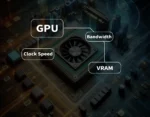Gadgetviza » Laptops » GPU Clock Speeds & VRAM Explained – Unlock Maximum Performance with Gaming!
GPU Clock Speeds & VRAM Explained – Unlock Maximum Performance with Gaming!
Understanding GPU Clock Speeds, Memory Bandwidth, and VRAM
In the context of graphics processing units (GPUs), clock speed and memory bandwidth are among the most significant factors that impact performance. Further, VRAM (Video RAM) is vital for storing graphic data optimally.
GPU Clock Speeds
A GPU’s clock speed, expressed in megahertz (MHz) or gigahertz (GHz), determines how rapidly the graphics processor can process instructions. Higher clock speeds result in faster computations, enhancing frame rates and rendering times in games and applications.
Core Clock
The core clock defines how quickly the GPU processes information, directly impacting performance.
Boost Clock
Boost clock is the GPU’s maximum possible speed under optimum conditions when both thermal and power limits permit.
Memory Clock
The memory clock determines the velocity at which video memory (VRAM) is run, and this influences data transfer rates as well as texture loading.
Memory Bandwidth
Memory bandwidth indicates the rate at which data can be read from or written to the GPU’s VRAM, measured in gigabytes per second (GB/s). This is an important metric for dealing with big textures, high resolutions, and detailed rendering.
Memory Interface Width
The memory interface width specifies the data path width (i.e., 128-bit, 256-bit, etc.). A wider interface enables more data to be moved in a single transfer, which is more efficient.
Memory Type
Current GPUs use GDDR6, GDDR6X, or HBM memory types, each with varying speed capabilities.
Effective Bandwidth
Effective bandwidth is a mix of memory speed and interface width, which decides real-world performance outcomes.
VRAM (Video RAM)
VRAM is graphics processing dedicated memory, holding textures, shaders, and other graphical data required for rendering. Additional VRAM improves smooth performance, especially for high-resolution gaming and creative work.
Effects of VRAM on Performance
Resolution & Texture Quality
Higher VRAM allows for higher resolution textures like 4K textures and complex shaders.
Frame Buffer Storage
Active frame buffer is stored in VRAM, resulting in smooth rendering and display updates.
Game Performance
Today’s games need a lower limit of 6GB to 8GB for 1440p and 4K gaming, while 12GB and above is best for demanding games.
Balancing GPU Clock Speed, Memory Bandwidth, and VRAM
A GPU’s performance is based upon a balance of clock speed, memory bandwidth, and adequate VRAM.
Increased Clock Speed
Increased clock speed provides quicker computation.
Greater Memory Bandwidth
Greater bandwidth provides faster rates of data transfer.
Adequate VRAM
Adequate VRAM avoids performance bottlenecks at resolutions that are high.
Final Thoughts
Gaming, creative applications, and high-performance computing require selecting a GPU with balanced clock speeds, high memory bandwidth, and adequate VRAM. A balanced GPU provides smooth gaming, optimal rendering, and quicker workloads.





